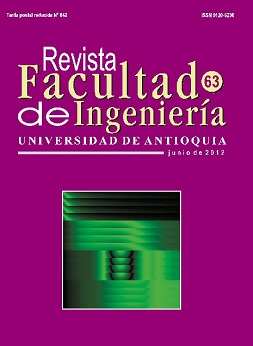Analysis and design of a low cost home automation prototype system
DOI:
https://doi.org/10.17533/udea.redin.12491Keywords:
home automation system, ambient intelligence, protocol, ZigBee, sensors, actuators, comfort, lighting, embedded system, home automationAbstract
This paper shows the evaluation and alternatives selection aimed to design a low cost domotic prototype system for didactic applications, under the framework of an investigation project carried out at Universidad de Antioquia. Supported in the state of the art we show the selection criteria and the different elements of the designed system. At the beginning some characteristic of the selected communication protocol are showed; then the boards and interface design are explained. Finally, the obtained results are pointed in order to demonstrate the correct operation of the prototype.
Downloads
References
M. Zamora, J. Santa, A. Gómez. “An Integral and networked home automation solution for indoor ambient intelligence.” Pervasive Computing IEEE. Vol. 9. 2010. pp. 66-77. DOI: https://doi.org/10.1109/MPRV.2010.20
J. Huidobro, R. Millán. Domótica: edificios inteligentes. Ed. Creaciones Copyright, S.L. Madrid. 2004. pp. 2-6.
K. Bromley, M. Perry, G. Webb. “Trends in Smart Home Systems, Connectivity and Services”. On line: www.nextwave.org.uk. 2003.
P. Moreaux, F. Sartor, F. Vernier. “An Effective Approach for Home Services Management”. 20th Euromicro International Conference on Parallel, Distributed and Network-based Processing. 2012. pp. 44-51. DOI: https://doi.org/10.1109/PDP.2012.45
G. Khusvinder, Y. Shuang-Hua, Y. Fang, L. Xin. “A ZigBee basede home automation System”. IEEE Transactions on Consumer Electronics. Vol. 55. 2009. pp. 422-430. DOI: https://doi.org/10.1109/TCE.2009.5174403
A. R. Al-Ali, M. Al-Rousan. “Java-based home automation system”. IEEE Transactions on Consumer Electronics. Vol. 50. 2004. pp. 498- 504. DOI: https://doi.org/10.1109/TCE.2004.1309414
N. Sriskanthan, F. Tan, A. Karande, “Bluetooth based home automation system”. Microprocessors and Microsystems. Vol. 26. 2002. pp. 281-289. DOI: https://doi.org/10.1016/S0141-9331(02)00039-X
H. Ardam, I. Coskun. “A remote controller for home and office appliances by telephone”. IEEE Transactions on Consumer Electronics. Vol. 44. 1998. pp. 1291-1297. DOI: https://doi.org/10.1109/30.735829
T. Baudel, M. Beaudouin-Lafon. “Charade: remote control of objects using free-hand gestures”. Communications of the ACM. Vol. 36. 1993. pp. 28-35. DOI: https://doi.org/10.1145/159544.159562
S. Kim, J. Kang, K. Lee, H. Park, S. Baeg, J. Park. A UPnP-ZigBee software bridge. In ICCSA. 2007. pp. 346-359. DOI: https://doi.org/10.1007/978-3-540-74472-6_28
M. Ruta, F. Scioscia, E. Di Sciascio, Giugeppe Loseto. “Semantic-Based Enhancement of ISO/IEC 14543-3 EIB/KNX Standard for Building Automation”. Ieee Transactions on Industrial Informatics. Vol. 7. 2011. pp. 731-739. DOI: https://doi.org/10.1109/TII.2011.2166792
M. Bastarrica, D. Gómez, C. Wilckens. “Input/ output autómatas como lenguaje de definición de arquitecturas”. Revista Facultad de Ingeniería - Universidad de Tarapacá. Vol. 13. 2005. pp. 77-87. DOI: https://doi.org/10.4067/S0718-13372005000100009
D. Chen,X. Li, S. Zhao. Auto-generation and redundancy reduction of test cases for reactive systems. 2nd International Conference on Software Technology and Engineering (ICSTE). 2010. pp. 125-130.
M. Barrera. “Domótica e inmótica: visión general y actualidad”. Revista AIE UdeA. 2011. pp. 13-19.
J. Augusto, C. Nugent. Designing Smart homes: The role of artificial intelligence. 1st ed. Ed. Springer. Berlin (Germany). 2006. pp. 1-8. DOI: https://doi.org/10.1007/11788485_1
J. Valverde. El estándar Inalámbrico ZigBee. Universidad Nacional de Trujillo. Trujillo, Perú. 2001. Disponible en: http://www.seccperu.org/files/ZigBee.pdf. Consultado marzo 2012.
ALCATEL. Tecnologias y actividades de estandarizacion para la interconexion de Home Networks. Para fundación Auna. Disponible en: http://fundacionorange.es/areas/historico/pdf/2.pdf. Consultado marzo 2012.
J. Hendrix, J. Kohl. ZigBee Overview. ZigBee Overview. 2009. Disponible en: https://docs.zigbee.org/zigbee-docs/dcn/09-4825.pdf. Consultado marzo 2012.
J. Tomé. Diseño de módulos ZigBee de bajo coste. Universidad Politécnica de Cataluña. España. 2006. Disponible en: http://upcommons.upc.edu/pfc/bitstream/2099.1/3581/1/53948-1.pdf. Consultado febrero 2012.
Digi International Inc. XBee®/XBee-PRO® ZB RF Modules. 2010. On line: ftp://ftp1.digi.com/support/documentation/90000976_G.pdf. Consultado febrero 2012.
R. Bayon. Gestión Técnica de las instalaciones en Edificios y Viviendas. Domotica. Universidad de Oviedo. España. 2010. Disponible en: http://156.35.98.1/ficheros/apuntes/domotica/PLC%20-%20Simatica%2005-06.pdf. Consultado febrero de 2012.
Green Energy Efficient Homes. What is it and does it really help cut your electricity bill? 2010. Disponible en: http://www.green-energy-efficient-homes.com/. Consultado enero 2012.
E. Oviedo, S. Velásquez, C. Isaza. Sistema de control de luz a partir de comandos de voz usando RNA. II Congreso De Microelectrónica Aplicada. Argentina. 2011. p. 39-44.
E. Oviedo, S. Velásquez. Sistema de reconocimiento de voz aplicado a la domótica. Tesis de pregrado. Departamento de Ingeniería Electrónica. Universidad de Antioquia. Medellín, Colombia. 2011. pp. 57.
Ministerio de Minas y Energía de Colombia. ABC de Uso Racional y Eficiente de Energía en Edificaciones. Disponible en: http://www.minminas.gov.co/minminas/downloads/UserFiles/File/OLGA%20BAQUERO/ABC%20de%20URE%20en%20edificaciones.pdf. Consultado enero 2012.
Downloads
Published
How to Cite
Issue
Section
License
Copyright (c) 2018 Revista Facultad de Ingeniería

This work is licensed under a Creative Commons Attribution-NonCommercial-ShareAlike 4.0 International License.
Revista Facultad de Ingeniería, Universidad de Antioquia is licensed under the Creative Commons Attribution BY-NC-SA 4.0 license. https://creativecommons.org/licenses/by-nc-sa/4.0/deed.en
You are free to:
Share — copy and redistribute the material in any medium or format
Adapt — remix, transform, and build upon the material
Under the following terms:
Attribution — You must give appropriate credit, provide a link to the license, and indicate if changes were made. You may do so in any reasonable manner, but not in any way that suggests the licensor endorses you or your use.
NonCommercial — You may not use the material for commercial purposes.
ShareAlike — If you remix, transform, or build upon the material, you must distribute your contributions under the same license as the original.
The material published in the journal can be distributed, copied and exhibited by third parties if the respective credits are given to the journal. No commercial benefit can be obtained and derivative works must be under the same license terms as the original work.










 Twitter
Twitter